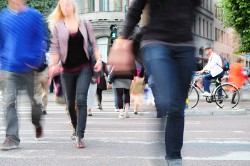Oregon Pedestrian Accident Attorney
Pedestrian Accidents
 As a pedestrian in the state of Oregon, it is to your benefit to know what your rights are in a world of busy streets, moving vehicles, and traffic. Fortunately, cyclist and lawyer, Ray Thomas, in conjunction with the Willamette Pedestrian Coalition, has taken the time to compile information about pedestrians and the law pertaining to them in the state of Oregon. With the information he has collected, Oregon Pedestrian Rights: A Legal Guide for Persons on Foot, was written. The following paragraphs are a summary of the key points about pedestrians and Oregon state law, and stand as a starting point from which to learn more about your rights as a pedestrian on the roadways. Whether you walk or run in Bend, Salem, Medford, Portland or anywhere else throughout the state, the following provides important information regarding your rights, and duties, on the roadways of Oregon.
As a pedestrian in the state of Oregon, it is to your benefit to know what your rights are in a world of busy streets, moving vehicles, and traffic. Fortunately, cyclist and lawyer, Ray Thomas, in conjunction with the Willamette Pedestrian Coalition, has taken the time to compile information about pedestrians and the law pertaining to them in the state of Oregon. With the information he has collected, Oregon Pedestrian Rights: A Legal Guide for Persons on Foot, was written. The following paragraphs are a summary of the key points about pedestrians and Oregon state law, and stand as a starting point from which to learn more about your rights as a pedestrian on the roadways. Whether you walk or run in Bend, Salem, Medford, Portland or anywhere else throughout the state, the following provides important information regarding your rights, and duties, on the roadways of Oregon.
What is The Vulnerable User Law?
The state of Oregon defines a pedestrian as “any person afoot or in a wheelchair,” which includes anyone from walkers, runners, and highway workers, to skateboarders and bicyclists. Oregon law permits pedestrians to cross the road at any point; however, local rules have the ability to make pedestrians rights somewhat unclear, as is the case in Portland, where pedestrians must use a crosswalk if one is available within 150 feet. If pedestrians are unaware of their rights and the rules which apply to them, a violation may entail potential legal traps or harsh penalties.
No state has ever used the Vulnerable Roadway User concept as a legal term, but members of the Bicycle Transportation Alliance wanted it instated for the protection of vulnerable user groups, such as the ones reducing energy consumption and pollution, while also improving their own health and fitness. Used in Europe by planners and safety organizations, the Vulnerable Roadway User Law applies to and protects people walking, running, using bicycles, farm tractors, skateboards, roller skates, roller blades, or scooters on the roadway. Before it was passed, Oregon state law provided only minor consequences for careless driving that seriously injures pedestrians or other non-motorized roadway users. Now, with the Vulnerable Roadway User Law in full effect, reckless drivers suffer enhanced penalties. Depending on the situation, the law mandates either community service and driver-improvement education, or a substantial fine and a mandatory one-year license suspension.
Crosswalks and Safety Islands
The Oregon definition of a crosswalk has not changed since its present parameters were created in 1975, and its definition includes, among other guidelines, “any portion of a roadway at an intersection or elsewhere that is distinctly indicated for pedestrian crossing by lines or markings on the surface of the roadway.” Keep in mind, though, while jaywalking is prohibited in the state of Oregon, current law requires drivers to stop and yield while pedestrians in crosswalks cross against the “don’t walk” signal of a traffic control device.
The responsibility of motorists in reference to pedestrians moving within a crosswalk is evident; however, pedestrians also have their own responsibility and “may not dart into the street in front of a motor vehicle that is close enough as to constitute an immediate hazard.” Although the pedestrian right of way is initiated as soon as the pedestrian steps off the curb into the crosswalk, it goes without saying that both the motorist and the pedestrian must exercise judgment and rational precaution when approaching any crosswalk. Also, it helps to keep in mind that when approaching motorists stop, vehicles overtaking in other lanes and moving in the same direction, are required by law to “follow the example and stop, too.”
On the other hand, when it comes to “safety islands,” Oregon states a driver does not need to stop on “a roadway with a safety island, if the driver is proceeding along the half of the roadway on the far side of the safety island from the pedestrian.” The safety island is best described as a resting spot, a safe zone, for pedestrians attempting to cross busy roadways. Although traffic on the opposite side does of the roadway does not have to stop, traffic on the side of the pedestrian is required to view a pedestrian on a safety island as a signal to stop, a good to know detail when legally necessary.
Out of any point throughout the past seventy years, right now Oregon state law provides the greatest amount of pedestrian crosswalk protection; even the definition of the word “crosswalk” has been improved upon, expanded, and made more definitive, thus reforming previous restrictions. No matter what or where, it always pays to keep in mind how local rules vary across the board and are not published widely, especially rules requiring pedestrians to cross roadways at crosswalks only. Such local laws can ultimately set a legal trap for unassuming pedestrians, so be aware and be knowledgeable of your rights.
Sidewalks, Shoulders, Bike Lanes, and the Roadway
 On the sidewalk, which is can be paved or unpaved and begins where the shoulder ends, Oregon law states “pedestrians have the right of way and all motorists and cyclists must yield to them.” The only stipulation for an area to be called a “sidewalk” is that it must “be capable of being used by a pedestrian.” On the shoulder, an area allotted for “emergency use” by motorist, pedestrians no longer maintain the right of way over vehicles. If a pedestrian is walking in an unsanctioned area and is hit, the driver is more than likely going to have a strong case in court. As far as bike lanes, laws are still in the process of being formulated and implemented; however, pedestrians are only to use a bike lane if there is no other viable and safe option. Even when using the bike lane as a last resort, pedestrians must yield to cyclists, as well as travel on the outside edge in the direction of traffic (opposite the flow of cyclists).
On the sidewalk, which is can be paved or unpaved and begins where the shoulder ends, Oregon law states “pedestrians have the right of way and all motorists and cyclists must yield to them.” The only stipulation for an area to be called a “sidewalk” is that it must “be capable of being used by a pedestrian.” On the shoulder, an area allotted for “emergency use” by motorist, pedestrians no longer maintain the right of way over vehicles. If a pedestrian is walking in an unsanctioned area and is hit, the driver is more than likely going to have a strong case in court. As far as bike lanes, laws are still in the process of being formulated and implemented; however, pedestrians are only to use a bike lane if there is no other viable and safe option. Even when using the bike lane as a last resort, pedestrians must yield to cyclists, as well as travel on the outside edge in the direction of traffic (opposite the flow of cyclists).
On the roadway, things are a different story, and pedestrians must yield the right of way to motorists. While cyclists have a certain “right to the road,” pedestrians do not, except of course, when in their safe zone of the crosswalk. Oregon state law permits pedestrian travel on the roadway only when there is no other option, such as a usable sidewalk or shoulder. Not only is improper proceeding on a roadway safe, it is also illegal and subject to ticketing.
No ID Required and Insurance Coverage
It’s simple: as a pedestrian, and in contrary to motorists, you have a right not to carry ID or to identify yourself (so long as conduct remains within legal jurisdiction).
Most people are not aware that certain aspects of automobile insurance policies cover you as a pedestrian. Personal Injury Protection will pay for medical bills and loss of income, and provide "no fault" coverage; Uninsured/Under-insured Motorist Coverage, in case the motorist is not insured or under-insured, ensures you are still taken care of. Check with your insurance company and see if it might be to your advantage to raise the minimums on your Personal Injury Protection. The cost to do so is generally nominal, and could be a tremendous help in the case of an accident; take the time now and make things easier for yourself in the future.



